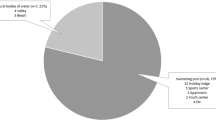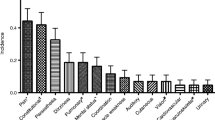Abstract
Background
This study aims to determine the potential risk factors associated with the development of severe diving-related spinal cord decompression sickness (DCS).
Methods
Two hundred and seventy nine injured recreational divers (42 ± 12 years; 53 women) presenting symptoms of spinal cord DCS were retrospectively included from seven hyperbaric centers in France and Belgium. Diving information, symptom latency after surfacing, time interval between symptom onset and hyperbaric treatment were studied. The initial severity of spinal cord DCS was rated with the Boussuges severity score, and the presence of sequelae was evaluated at 1 month. Initial recompression treatment at 2.8 ATA with 100% oxygen breathing or deeper recompression up to 4 or 6 ATA with nitrogen or helium–oxygen breathing mixture were also recorded.
Results
Twenty six percent of DCS had incomplete resolution after 1 month. Multivariate analysis revealed several independent factors associated with a bad recovery: age ≥42 [OR 1.04 (1–1.07)], depth ≥39 m [OR 1.04 (1–1.07)], bladder dysfunction [OR 3.8 (1.3–11.15)], persistence or worsening of clinical symptoms before recompression [OR 2.07 (1.23–3.48)], and a Boussuges severity score >7 [OR 1.16 (1.03–1.31)]. However, the time to recompression and the choice of initial hyperbaric procedure did not significantly influence recovery after statistical adjustment.
Conclusions
Clinical symptoms of spinal cord DCS and their initial course before admission to the hyperbaric center should be considered as major prognostic factors in recovery. A new severity score is proposed to optimize the initial clinical evaluation for spinal cord DCS.

Similar content being viewed by others
References
Francis TJR, Mitchell SJ. Manifestations of decompression disorders. In: Brubbak AO, Neuman TS, editors. The Bennett and Elliot’s physiology and medicine of diving. 5th ed. London: WB Saunders; 2003. p. 578–99.
Gempp E, Blatteau JE. Risk factors and treatment outcome in scuba divers with spinal cord decompression sickness. J Crit Care. 2010;25(2):236–42.
Francis TJR, Mitchell SJ. Pathophysiology of decompression sickness. In: Brubbak AO, Neuman TS, editors. The Bennett and Elliot’s physiology and medicine of diving. 5th ed. London: WB Saunders; 2003. p. 530–56.
Hallenbeck JM. Cinephotomicrography of dog spinal vessels during cord damaging decompression sickness. Neurology. 1976;25:190–9.
Thalmann ED. Principles of US Navy recompression treatments for decompression sickness. In: Moon RE, Sheffields PJ, editors. Diving accident management. Bethesda, MD: Undersea and Hyperbaric Medical Society; 1996. p. 75–95.
Weaver LK. Monoplace hyperbaric chamber use of US Navy table 6: a 25-year experience. Undersea Hyperb Med. 2006;33:85–8.
Shupak A, Melamed Y, Ramon Y, et al. Helium and oxygen treatment table of severe air-diving-induced neurologic decompression sickness. Arch Neurol. 1993;54:305–11.
Bond JG, Moon RE, Morris DL. Initial table treatment of decompression sickness and arterial gas embolism. Aviat Space Environ Med. 1990;61:738–43.
Leitch DR, Green RD. Additional pressurisation for treating nonresponding cases of serious air decompression sickness. Aviat Space Environ Med. 1985;56:1139–43.
Ross JAS. Clinical audit and outcome measures in the treatment of decompression illness in Scotland. A report to the National Health Service in Scotland Common Services Agency, National Services Division on the conduct and outcome of treatment for decompression illness in Scotland from 1991–1999. Aberdeen, UK: Department of Environmental and Occupational Medicine, University of Aberdeen Medical School; 2000.
Robertson AG. An analytic survey of 111 cases of decompression sickness. Undersea Biomed Res. 1991;18(Suppl):47.
Desola J, Sala J, Bohe J, et al. Prognostic factors of dysbaric disorders. Evidence-based conclusions after a multivariant analysis of 554 cases. In: Cali-Corleo R, editors. Proceedings of the 26th annual meeting of the European underwater and baromedical society, Valetta, Malta, 2000, pp 17–23.
Rivera JC. Decompression sickness among divers: an analysis of 935 cases. Mil Med. 1964;129:134–334.
Dick APK, Massey EW. Neurologic presentation of decompression sickness and air embolism in sport divers. Neurology. 1985;35:667–71.
Francis TJR, Dutka AJ, Flynn ET. Experimental determination of latency, severity and outcome in CNS decompression sickness. Undersea Biomed Res. 1988;15:419–27.
Méliet JL, Mayan PY. The prognosis of decompression sickness in the French Navy: influence of latency and time of recompression. Bull Medsubhyp. 1990;9:63–75 [in French].
Aharon-Peretz J, Adir Y, Gordon CR, et al. Spinal cord decompression sickness in sport diving. Arch Neurol. 1993;50:753–6.
Van Hulst RA. Analysis of ten year diving casualties 1979–1989, diving medical centre, The Netherlands. Undersea Biomed Res. 1990;17(Suppl):144.
Kizer KW. Delayed treatment of dysbarism. A retrospective review of 50 cases. JAMA. 1982;247:2555–8.
Ball R. Effect of severity, time to recompression with oxygen, and re-treatment on outcome of forty-nine cases of spinal cord decompression sickness. Undersea Hyperb Med. 1993;20:133–45.
Stipp W. Time to treatment for decompression illness. Research report RR 550, Norwich, UK, Health and Safety Executive Books, pp 1–29 (2007). http://www.hse.gov.uk/research/rrpdf/rr550.pdf.
Blanc P, Boussuges A, Bergmann E, Sainty JM. Delay of initial treatment and hyperbaric oxygen therapy in neurological decompression sickness. Urgences 1994;4:177–80 [in French].
Desola J, Sala J, Bohe J, et al. Outcome of dysbaric disorders is not related to delay in treatment. Preliminary results of a multi-variate analysis of 466 cases following a prospective study. In: Mekjavic IB, Tipton MJ, editors. Proceedings of the 23rd annual scientific meeting of the European underwater and Baromedical Society, Bled, Slovenia, 1997, pp 133–38.
Boussuges A, Thirion X, Blanc P, et al. Neurologic decompression illness: a gravity score. Undersea Hyperb Med. 1996;23:151–5.
Berghage TE, Vorosmarti J, Barnard EPP. Recompression treatment tables used throughout the world by government and industry. Bethesda, MD: Naval Medical Research Institute. http://archive.rubicon-foundation.org/34141978.
Closon M, Vivier E, Breynaert C, et al. Air embolism during an aircraft flight in a passenger with a pulmonary cyst: a favorable outcome with hyperbaric therapy. Anesthesiology. 2004;101:539–42.
Wattel F, Mathieu D, editors. Proceedings of the 2nd European consensus conference on hyperbaric medicine on the treatment of decompression accidents in recreational diving, 9, 11 May 1996, Marseille, France.
Hanley JA, MacNeil BJ. A method of comparing the areas under receiver operating characteristic curves derived from the same cases. Radiology. 1983;148:839–43.
Divers Alert Network. The DAN annual review of recreational SCUBA diving injuries and fatalities based on 1999 data. Report on decompression illness, diving fatalities and project dive exploration. Durham: Divers Alert Network; 2001.
Divers Alert Network. The DAN annual review of recreational SCUBA diving injuries and fatalities based on 2003 data. Report on decompression illness, diving fatalities and project dive exploration. Durham: Divers Alert Network; 2005.
Blatteau JE, Guigues JM, Hugon M, et al. Air diving with decompression table MN90. 12 years of use by the French navy: study about 61 decompression sickness for 1990–2002. Sci Sports (French) 2005; 20:119–123.
Pitkin AD, Benton PJ, Broome JR. Outcome after treatment of neurological decompression illness is predicted by a published clinical scoring system. Aviat Space Environ Med. 1999;70:517–21.
Gempp E, Blatteau JE, Stephant E, et al. MRI findings and clinical outcome in 45 divers with spinal cord decompression sickness. Aviat Space Environ Med. 2008;79:1–5.
Brubakk AO. On-site recompression treatment is acceptable for DCI. SPUMS J. 2000;30:166–73.
Smith LA, Hardmann JM, Beckman EL. Immediate in water recompression. Does it make a difference in the pathology of central nervous system decompression sickness? Undersea Hyperb Med 1994. http://archive.rubicon-foundation.org/5632.
Lee HC, Niu KC, Chen SH, et al. Therapeutic effects of different tables on type II decompression sickness. J Hyperb Med. 1991;6(1):11–7.
Drewry A, Gorman DF. A preliminary report on a prospective randomised double-blind controlled study of oxygen and oxygen-helium in the treatment of air diving decompression illness. Undersea Hyperb Med. 1993;20:19–20.
Hyldegaard O, Kerem D, Melamed Y. Effect of combined recompression and air, oxygen, or heliox breathing on air bubbles in rat tissues. J Appl Physiol. 2001;90:1639–47.
Cianci P, Slade JB. Delayed treatment of decompression sickness with short, no-air break tables: review of 140 cases. Aviat Space Environ Med. 2006;77:1003–8.
Acknowledgments
We would like to thank Pascal Constantin and Christel Blassin for their pertinent linguistic reviewing.
Author information
Authors and Affiliations
Corresponding author
Rights and permissions
About this article
Cite this article
Blatteau, JE., Gempp, E., Simon, O. et al. Prognostic Factors of Spinal Cord Decompression Sickness in Recreational Diving: Retrospective and Multicentric Analysis of 279 Cases. Neurocrit Care 15, 120–127 (2011). https://doi.org/10.1007/s12028-010-9370-1
Published:
Issue Date:
DOI: https://doi.org/10.1007/s12028-010-9370-1




